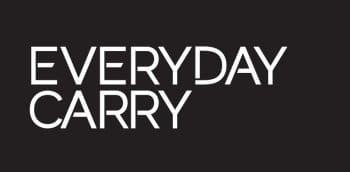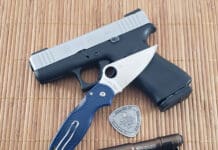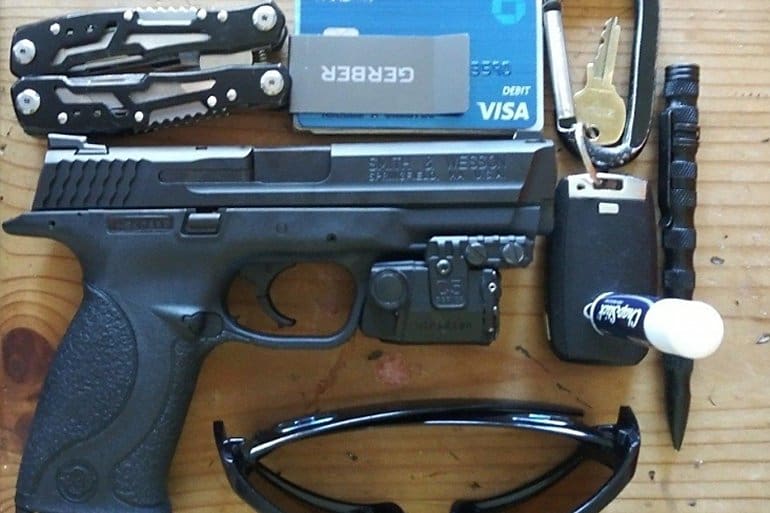Calhoun from Fayetteville, NC sends his “LOVE covers all” submission to us for today’s Everyday Carry Pocket Dump of the Day.
If you’re like me, you’re thinking, “that’s a lot of add-ons for a defensive handgun.” Well that and “where’s the holster, mate?”
The gun, a Canik TP9SF Elite Combat 9mm is no doubt a nice gun. Then he throws on a 1500 lumen Olight Valkyrie weapon light (can you spell overkill?) and a UTG reflex microdot. Is anyone else old enough to remember when UTG started out (or so it seemed) as a airsoft gear company? They’ve certainly improved their reputation for quality in recent years. Originally, well, let’s just say it was airsoft stuff.
Calhoun also wears a watch and carries a WESN Allman folder knife. Unlike many, he shares his preferred self-defense load in Speer Gold Dot 9mm JHP.
His additional comment:
“…he who has no sword, let him sell his garment and buy one.” -Luke 22:36
Amen, brother.
No doubt this is a relatively afford.






Cool looking knife.
Would like to see the holster he totes that tweaked out pistol in everyday.
Wow !!
Looks exactly like my EDC except for the pistol, the light, the watch, the knife, the mag and ammo. Otherwise, just the same.
😂
This may sound snarky, but not meant that way: when he turns on that 1500 lumen eyeball shredder in a dark room, isn’t he going to be blinded for a moment?
Or a day…..😎
If it’s blinding when pointed downrange, imagine how blinding it would be pointed at your eyes…
And isn’t “seeing the light” something some aspire to? 😉
https://www.youtube.com/watch?v=xtolv9kM1qk
If you’re an idiot, yes. Umbrella or baseboard. Pick one and use it.
“…he who has no sword, let him sell his garment and buy one.”
Okay so two questions:
1. What sort of garment was it that after selling, you could afford to buy a sword? I mean that ain’t no cheap ugly Christmas sweater we are talking about here!
2. Having sold garment to buy a sword, well, so now we all have swords but we are naked? Do we really all wanna go around naked carrying swords? And what do we sheathe them in? And what are all these sword salesmen going to do with all those garments that got traded in for swords?
Alright so that’s really more than two questions, but I just do not see the economy of this plan being at all viable.
That garment you sold is now worth $10,000, because everyone else got rid of theirs, due to predicted extreme global warming. The salesman is selling all those garments to anti-sword people. Your sword came with a really cool “holster”. It’s big enough to cover you and store your lunch.
“1. What sort of garment was it that after selling, you could afford to buy a sword?”
Ever priced a coat rated to handle polar regions? Good ones can run 1500 bucks…
Curiously, I have spent many months working south of the Antarctic Circle. Luckily, all expenses were covered including the polar rated clothing from the underwear to the outer layers.
Being familiar with such garments as well as hot desert places too I’m pretty sure the garment costs are very different.
The first thing to consider is what “sword” means.
It depends on where you are and when. Technically there is no hard demarcation where a knife becomes a large knife becomes a sword and there never has been. In Jesus’ time people generally think of a Roman spatha but the area would have been heavily influenced by the usually smaller Greek xiphos.
Considering where Jesus was and when he was there the term “sword” could heave meant anything from basically a dagger (the Spartan xiphos, a “military sword” that was used to great effect was about a foot of blade) up to a full sized spatha (2 to 2.5 feet in length).
Prices would reflect the size, quality and materials of the blade.
Clothing was not limited to a cloak. People generally wore a tunic with a cloak over it so they’re selling the outer garment, not walking around nude, if they follow this advice.
Further still, a quality cloak at the time was extremely expensive compared to other daily items because making the fabric was ungodly costly. A good cloak cost 3/5 to 2/3rds of what your average person made in a YEAR.
To put that in perspective compared to average income in the United States for 2017, that’s about $29,000 ($28,890 actually). You can buy a fair bit of firepower for that.
Textiles were a whole heaping lot more expensive in ancient times than they are now. Fine robes made from silk or other fabrics could cost as much as several slaves. Some translations say “cloak” either way, it was likely a coat, cloak, or similar garment and I doubt you would be naked if it were sold. A sword certainly wouldn’t be cheap either but a small one could probably be doable.
A suit today isn’t cheap, neither are great coats, you could sell one and easily afford a modern weapon. Though the cost of both have come down significantly.
China, Guatemala, and Vietnam were not exporting their cheap labor products so clothes took more income to purchase, so a cloak would be heavy-duty and more expensive than just a shirt.
Swords were probably expensive, but they were in the time of the gladius which is short (as swords go). We dont know about the steel used in all swords at the time. So think machete vs a Toledo blade.
Clothes and food weren’t always as dirt cheap as they are now.
Let me add a couple of quotes from some of the great Austrian School economists;
The characteristic feature of modern capitalism is mass production of goods destined for consumption by the masses. . . On the market of a capitalistic society the common man is the sovereign consumer whose buying or abstention from buying ultimately determines what should be produced and in what quantity and quality.
Ludwig Von Mises
+
The capitalist engine is first and last an engine of mass production which unavoidably also means production for the masses. . . . It is the cheap cloth, the cheap cotton and rayon fabric, boots, motorcars and so on that are the typical achievements of capitalist production, and not as a rule improvements that would mean much to the rich man. Queen Elizabeth owned silk stockings. The capitalist achievement does not typically consist in providing more silk stockings for queens but in bringing them within reach of factory girls in return for steadily decreasing amounts of effort.
Joseph Shumpeter
Prior to capital driven mass production everything was hand made, artisan, and much more expensive.
Traded in a pair of levis, got a Best Choice™ disposable razor
Most translations I’ve seen of that verse say “cloak,” not “garment.” If he’d quoted one of those, this whole conversation would be moot.
Soooooo what does “love covers all” mean? I’m missing something here.
So it’s going to be a bible verse. Proverbs 10:12. NIV
“Hatred stirs up conflict,
but love covers over all wrongs.“
https://www.biblegateway.com/passage/?search=Proverbs+10%3A12&version=NIV
And the reference is probably there because of the way he spelled “love” out with his gear the same way people will do it with less tactical items.
Girls With Guns has had a gun related “Love” logo on shirts and hats for a while too.
https://gwgclothing.com/shop/womens-gwg-love-tee-black/
A robe probably cost as much as sword back then. It took a lot of work to make cloth back then.
1500 lumens. A 100 watt bulb is around 1000 lumens. Pardon the pun but that’s overkill!
No such thing as too many lumens with any weapon mounted light. At least yet. And lumens is meaningless without candela numbers as well.
Another case of taking a very concealable pistol and turning it into something resembling a cell phone tower. Nearly as concealable also.
You’ve clearly never carried one in a decent holster. A t-shirt conceals that gun.
Am I the only one who’s a bit leery on red dots on concealed pistols trope? I mean, people will lambast revolvers with a hammer spur because it could hypothetically get caught on something when pulling it out on the holster, but having a protruding, sharper angled peice of metal on top of a semi auto is a-okay? Not to mention you have to turn it on, change the batteries, etc.?
I generally agree with you…..except for the red dor power.
Most of these new red dots are always on and the battery will power them for years.
Thanks for clearing that up. I’m a millennial, but I’m raised by baby boomers, and my first experience with laser optics was something akin to the laser sight Arnold had on the long slide 1911 in the first Terminator.
Holy smokes! Egads! Get into the 21st century man. We have all kids of cool laser and dot, and holographic lookin’ through thingamajiggies 😉
Hell I had a laser on an M11 back in the early 90’s that was about 1/8 the size of that monster Arnold had. Maybe smaller. It was small enough that it mounted under the barrel and didn’t protrude past the muzzle.
If you dig around on TTAG they did an article within recent memory on the differences between and advantages and disadvantages of lasers, dots, and other modern sighting systems, excluding regular scopes.
A proper draw gets the gun out with or without one. A snagged red dot usually means your draw was bad and would of happened with a slick gun. And a red dot will normally slip off something like a shirt because a good one like an rmr is angled away from the shooter slightly, where a hammer is angled towards them, making a hammer want to catch material and the red dot slip off.
Is this red dot trustworthy enough to eliminate back up iron sights?
On a comp gun yes, SD gun no.
The EDC loadout that tells the world ‘I’m gay and I’m proud!’
Well isn’t that cute. Now I’m inspired to make my EDC spell DEATH.
Sorry, old school here, weapon mounted lights just gives your oponent something to shoot at. I’m sure there are others that disagree, but that’s what I was taught 40 years ago, and I still believe and carry that way today. Gun, light knife and spare mag, check. Holster? Hmmm. Throwing a UTG Microdot on? IDK, they’ve improved yes, but when you spend more on a light and knife than on an optic, I’ve got to question your priorities.
Speer Gold Dot is a LEO Standard, ballistically I prefer the Hornady Critical Duty 135gr. +P.
As for the quote from Jesus in Luke 22:36, most theologians consider it a fulfillment of the Isaiah prophecy “He shall be counted among the lawless,” and nothing more.
Comments are closed.